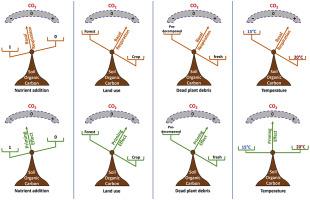Soil Biology and Biochemistry ( IF 9.8 ) Pub Date : 2020-11-30 , DOI: 10.1016/j.soilbio.2020.108103 Raphaël Guttières , Naoise Nunan , Xavier Raynaud , Gérard Lacroix , Sébastien Barot , Pierre Barré , Cyril Girardin , Bertrand Guenet , Jean-Christophe Lata , Luc Abbadie

|
Any change in the intensity and sign of CO2 flux between soil and atmosphere is expected to have a significant impact on climate. The net emission of CO2 by soils depends on antagonistic processes: the persistence of dead plant matter and the mineralization of soil organic matter. These two processes are partly interdependent: their interaction is known as the “priming effect” (PE), i.e. the stimulation of the mineralization of stable soil organic matter by more labile fresh organic matter.
Documenting the response of PE to global change is needed for predicting long term dynamics of ecosystems and climate change. We have tested the effects on PE of temperature, nutrient availability, biodegradibility of added organic matter (fresh vs. decomposed), soil cover (agricultural vs. forest soil) and interactions.
Our results suggest that the biodegradability of plant debris (wheat straw, fresh or pre-decomposed) is the first determinant of the intensity of PE, far ahead of temperature and nutrients: fresh wheat straw addition induced up to 800% more CO2 emission than pre-decomposed one. The raise of temperature from 15 to 20 °C, increased basal soil organic matter mineralization by 38%, but had little effect on PE. Interactions between biodegradability of straw and the other factors showed that the agricultural soil was more responsive to all factors than the forest soil.
We have shown in our study that the intensity of PE could be more dependent on soil cover and plant residue management than on other drivers of global change, particularly temperature and nutrients. There is an urgent need to assess the genericity of our results by testing other soil types and plant debris for a better integration of PE in models, and for identifying alternative land carbon management strategies for climate change mitigation.
中文翻译:

温度和土壤管理对碳通量和启动效应强度的影响
土壤和大气之间的CO 2通量强度和符号的任何变化都有望对气候产生重大影响。土壤CO 2的净排放量取决于拮抗过程:死植物物质的持久性和土壤有机物的矿化。这两个过程在某种程度上是相互依存的:它们的相互作用被称为“启动效应”(PE),即,不稳定的新鲜有机物刺激稳定的土壤有机物的矿化作用。
要预测生态系统和气候变化的长期动态,就需要记录PE对全球变化的响应。我们已经测试了温度,养分利用率,添加的有机物(新鲜与分解),土壤覆盖率(农业与森林土壤)和相互作用之间对PE的影响。
我们的研究结果表明,植物残渣(麦秸秆,新鲜或预先分解)的生物降解性是PE强度的第一决定因素,远高于温度和养分:添加新鲜麦秸比未加工麦秸诱导的CO 2排放高800%预分解的。温度从15升高到20°C,使基础土壤有机质矿化增加38%,但对PE影响不大。秸秆的生物降解性与其他因素之间的相互作用表明,农业土壤比森林土壤对所有因素的反应更快。
我们的研究表明,PE的强度可能更依赖于土壤覆盖和植物残留管理,而不是全球变化的其他驱动因素,尤其是温度和养分。迫切需要通过测试其他土壤类型和植物残渣来评估结果的通用性,以更好地将PE与模型整合,并确定用于缓解气候变化的替代土地碳管理策略。











































 京公网安备 11010802027423号
京公网安备 11010802027423号